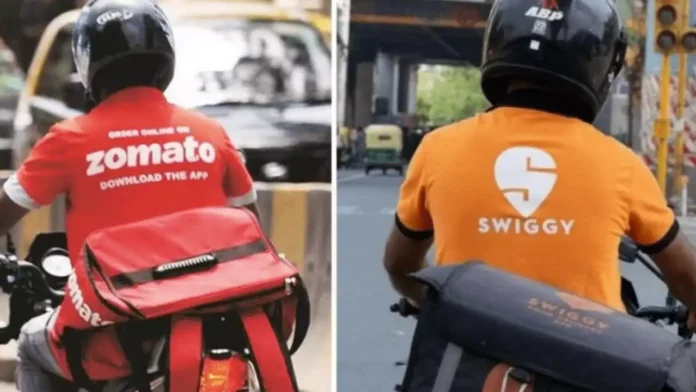A slowdown in user addition over the last few quarters has led online food-delivery platforms Zomato and Swiggy to prioritize increasing the frequency of orders from existing customers as a means to drive growth.
During fiscal 2024, Zomato experienced an 8% year-on-year increase in its average monthly transacting user base, reaching 18.4 million. This growth rate marks a slowdown compared to the 16% pace achieved in the preceding fiscal year.
Although Swiggy’s figures are not publicly disclosed, analysts have indicated that the IPO-bound company has also experienced a similar rate of slowdown in user growth.
According to data released by its largest investor, Prosus, Swiggy witnessed a 17% year-on-year growth in gross merchandise value (GMV) for food delivery in the first half of 2023. This marks a significant deceleration from the 40% growth recorded during the same period in 2022.
Continue Exploring: Swiggy files confidential draft papers with SEBI for IPO launch
According to a senior Zomato executive, the company’s current focus is on promoting increased order frequencies rather than prioritizing the acquisition of “more expensive” new customers.
“The growth in food delivery is predominantly steered by either elevating the average order value (AOV) or fostering higher order frequency. Currently, the average order frequency stands at two to three times… There’s still considerable ground to cover in terms of the addressable market, but it’s a strategic long-term endeavor,” stated the executive.
Strategies to Drive Growth
In recent quarters, Zomato has introduced a variety of new features and options for food delivery. These include a vegetarian-only mode, accommodating larger orders, promoting healthier food choices, expanding Zomato Everyday, and making several minor tweaks on the app, such as introducing “desk-friendly” options.
Continue Exploring: Zomato continues experimenting new initiatives, rolls out new feature to help users make healthier food choices
“Our Gold program has also significantly contributed to increasing order frequency,” shared the executive. The erosion in margins from discounts and free deliveries under the Zomato Gold subscription program is being offset by the increase in advertising revenue and platform fees that the company levies, the executive elaborated.
Zomato and Swiggy both charge a platform fee of INR 5 per order to their food delivery users.
Swiggy has also rolled out new features and choices to cater to a broader range of use cases for both existing and new customers. Among these are budget-friendly food selections available through ‘Pockethero’. Additionally, the Bengaluru-based company has collaborated with IRCTC to provide food delivery services on trains.
Queries directed to Zomato and Swiggy went unanswered.
Market Dynamics and Industry Insights
According to a March report from Baron Capital, a Gurgaon-based Zomato currently holds a 55% market share in the duopolistic food delivery sector, overshadowing its competitors.
Analysts and industry insiders note that as both companies expand their quick-commerce ventures—Zomato’s Blinkit and Swiggy’s Instamart—within food delivery, they are now striving to strike a balance between growth and profitability.
Continue Exploring: Quick commerce platforms Blinkit and Zepto expand into e-commerce, targeting fashion, beauty, electronics, and more
A Mumbai-based analyst at a global brokerage firm remarked, “Neither of the companies are burning excessive cash to fuel growth as they did a few years ago to capture a larger market share… coupled with macroeconomic challenges, this trend is impeding user growth.”
Even amidst the Indian Premier League cricket tournament, a time when companies typically invest heavily in advertising and marketing, growth this year remained subdued compared to previous years.
Financial Performance
According to a research report from brokerage firm Citi, Zomato experienced a 6% increase in daily average users on Android during the initial 30 days of this year’s IPL season, marking a slower growth rate compared to the 2022 and 2023 seasons.
Karan Taurani, senior vice president at Elara Capital, highlighted that Zomato is currently prioritizing striking a balance between expansion and profitability.
He mentioned, “We’ve observed a notable increase in Zomato’s margins over the past 4-5 quarters, moving from breakeven to a 3.3% EBITDA.”
Taurani added, “User growth for internet companies, previously around 20-25%, has tapered to 10-15%. This shift reflects a prioritization of profitability over rapid expansion. Many companies in the internet and ecommerce sectors are refraining from aggressive user acquisition, considering it could impact their margins negatively.”
Significantly, the food delivery sector has witnessed the emergence of the government-supported Open Network for Digital Commerce (ONDC), allowing major internet players like Ola and Paytm to incorporate food delivery services within their applications.
According to a recent consumer survey released by Bank of America Global Research, 60% of respondents have utilized ONDC apps for food ordering and intend to maintain this practice in the future. The survey noted that only 11% of users expressed dissatisfaction with their experience using the service.
Continue Exploring: ONDC facilitates 7.22 Million transactions in April, onboards over 5 Lakh sellers


